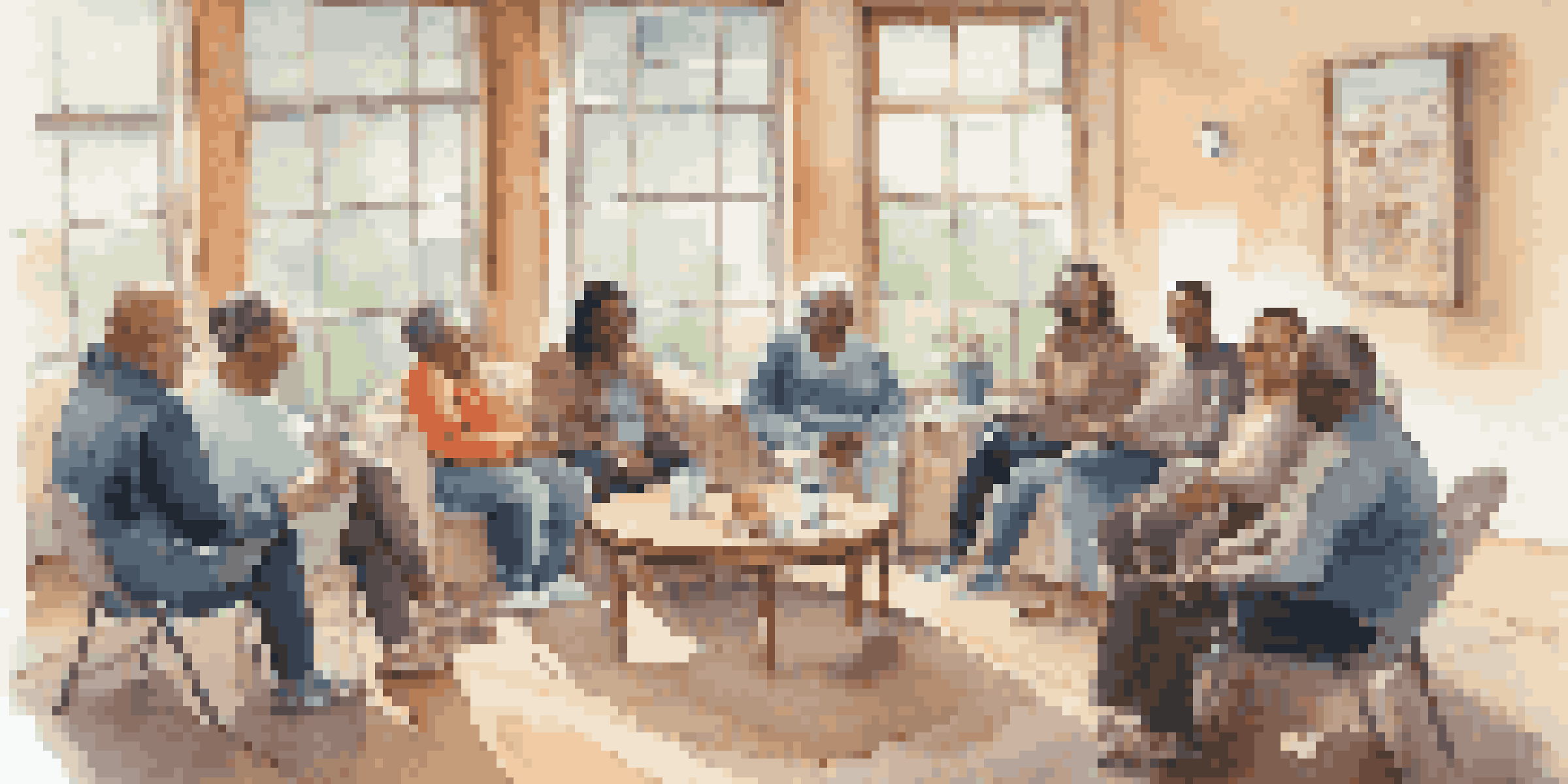The Impact of Community Support in Chronic Pain Management

Understanding Chronic Pain and Its Challenges
Chronic pain is a complex condition that affects millions of people worldwide. Unlike acute pain, which stems from a specific injury, chronic pain persists over time, often without a clear cause. This ongoing discomfort can lead to emotional distress, anxiety, and social isolation, making management even more challenging.
Pain is inevitable. Suffering is optional.
The multifaceted nature of chronic pain means that treatment often requires a holistic approach. Medications, physical therapy, and lifestyle changes can help, but many individuals find that support from others plays a crucial role in their journey. This is where community support can make a significant difference.
When individuals with chronic pain connect with others who understand their struggles, it fosters a sense of belonging and validation. This shared experience can help alleviate feelings of loneliness and helplessness, which are common among those dealing with chronic conditions.
The Role of Peer Support Groups
Peer support groups are vital for individuals managing chronic pain. These groups provide a safe space for sharing experiences, coping strategies, and emotional support, creating a community where individuals feel understood. Hearing others' stories can inspire hope and provide insights into different management techniques.

In these groups, participants often share practical tips on managing pain and navigating daily challenges. Whether it’s discussing effective exercises, dietary changes, or mindfulness techniques, the collective knowledge in these settings can be invaluable. This kind of shared wisdom often leads to discovering new approaches to pain management.
Chronic Pain Needs Community Support
Connecting with others who understand chronic pain fosters a sense of belonging and alleviates feelings of isolation.
Moreover, the emotional support garnered from these groups can significantly reduce feelings of isolation. Knowing that others are facing similar struggles can help individuals feel less alone, promoting a sense of camaraderie that is vital for mental well-being.
The Benefits of Online Communities
In today’s digital age, online communities have emerged as powerful platforms for those with chronic pain. These virtual spaces allow individuals to connect with others from around the globe, breaking geographical barriers. Online forums, social media groups, and dedicated websites offer a wealth of information and support.
The greatest healing therapy is friendship and love.
Online communities provide the flexibility to engage at one's own pace, which is particularly beneficial for those dealing with chronic pain. Members can participate in discussions, seek advice, or simply observe, all from the comfort of their homes. This accessibility encourages more people to seek support without the need for physical travel.
Additionally, anonymity in online spaces can empower individuals to share their experiences more freely. This openness can lead to deeper connections and more honest discussions about the challenges of living with chronic pain, further enhancing the sense of community.
Encouraging Family and Friends' Support
While peer support is critical, the role of family and friends in chronic pain management cannot be understated. Loved ones can provide emotional support, practical help, and companionship, making a significant difference in an individual's daily life. Encouraging open conversations about pain can help family members understand the condition better and provide appropriate support.
Educating family and friends about chronic pain is essential. When loved ones understand the nuances of the condition, they can offer more empathetic support and avoid unhelpful comments. This education can also help them recognize the importance of patience and encouragement.
Online Communities Enhance Connection
Digital platforms provide individuals with chronic pain the flexibility to connect and share experiences, breaking geographical barriers.
Moreover, involving family in support groups or therapy can strengthen relationships. When family members participate in understanding the challenges together, it fosters a shared commitment to managing pain, creating a stronger support network.
The Impact of Local Community Resources
Local community resources, such as pain management clinics, wellness centers, and educational workshops, play a vital role in supporting individuals with chronic pain. These services often provide access to trained professionals who can offer tailored advice and treatment options. Engaging with these resources can empower individuals to take an active role in their pain management.
Community resources also often host events, such as exercise classes or informational seminars, that encourage social interaction among participants. This not only promotes physical health but also helps build connections among individuals facing similar challenges. The sense of community that arises from shared activities can be incredibly uplifting.
Additionally, local resources can connect individuals with volunteer programs or mentorship opportunities. Being part of a supportive network can help individuals feel valued and recognized, boosting their overall morale and resilience in managing their chronic pain.
Harnessing Technology for Support
Technology has revolutionized the way individuals manage chronic pain, providing tools for both medical treatment and community support. Mobile apps designed for pain tracking can help users monitor their symptoms and identify triggers, offering valuable insights for both individuals and healthcare providers. This data can be shared within support communities to enhance collective understanding.
Telehealth services have also made it easier for individuals to connect with healthcare professionals without the need for in-person visits. This convenience is especially beneficial for those with mobility issues or chronic fatigue, ensuring they receive the care they need while maintaining connections with their support networks.
Advocacy is Key for Chronic Pain
Raising awareness and advocating for better resources can significantly improve the lives of those living with chronic pain.
Furthermore, online platforms allow for the sharing of resources, research findings, and personal stories, creating a rich tapestry of information. By harnessing technology, individuals can access a broader community of support, fostering resilience and encouraging proactive pain management strategies.
The Importance of Advocacy and Awareness
Advocacy plays a crucial role in improving the lives of those living with chronic pain. Raising awareness about the condition can help eliminate stigma and promote understanding within communities. When more people recognize the challenges of chronic pain, it can lead to increased support and resources for those affected.
Community support initiatives can also drive advocacy efforts. Local groups can organize campaigns, workshops, or events that educate the public about chronic pain, fostering empathy and understanding. This grassroots approach can lead to meaningful changes in how society views and supports individuals with chronic conditions.

By advocating for better resources, research funding, and policy changes, communities can help improve the overall quality of life for those living with chronic pain. Together, individuals can create a powerful voice that drives positive change, paving the way for greater support and understanding.